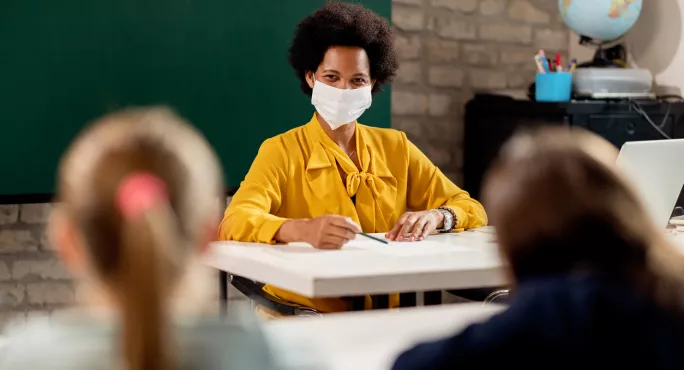- Home
- Covid and schools: a virologist’s view on staying safe
Covid and schools: a virologist’s view on staying safe

The latest guidelines for schools state that when a child tests positive for Covid-19, only “close contacts” have to self isolate.
There are two drawbacks to these current recommendations: firstly, the lack of accessibility to tests, which - as I have stated in a previous article - could be resolved for schools through routine saliva-based pooled PCR testing; and secondly, the subjective nature of the term ‘close contact’.
Consequently, the approaches adopted by schools in response to Covid-19 have been hugely variable, from isolating multiple bubbles, individual bubbles to just rows of students.
Coronavirus schools guidance
In certain circumstances, teachers have also been expected to continue working despite what would be deemed ‘close contact’.
Similarly, there has been an evident disparity between the Covid-19 measures being implemented daily in classrooms, both between schools and within schools, too.
We need some consistency. And understanding the science behind public health guidelines could equip schools to make informed decisions about in-house Covid-19 policies, and importantly, ensure that teachers and students feel safe.
So what do schools need to know?
How is coronavirus transmitted?
First, it is important to understand transmission.
SARS-CoV2 transmits primarily via respiratory droplets, which are released upon talking, coughing, sneezing etc. Due to these droplets being ‘large and heavy’, they tend not to remain suspended in the air for long, requiring proximity between two people for infection.
Transmission through contaminated surfaces may also be a route, although this has recently been debated and suggested to present only a small risk i.e. the virus is infectious for only hours rather than days on an inanimate surface following contact with an infected person or respiratory droplets. This could still be a key route of transmission in schools, though.
Read more:
Where are the infection hotspots in schools: An overview for teachers
Should teachers wear face masks? A professor of public health gives her view
Coronavirus: Can children socially distance?
Additionally, aerosol transmission. Experts now believe that the virus may transmit through smaller droplets. Unlike respiratory droplets, these can travel further and linger in enclosed, poorly ventilated spaces, such as classrooms.
A current study aims to determine how long the virus in such air samples is infectious. It has been estimated that SARS-CoV2 has an aerosol half-life of approximately 1-hour. This means that if 50 virus particles were suspended in the air, 25 virus particles would drop out of the air after one hour, but the other 25 would still remain, and so on.
What is an infectious dose?
The second key point is: what is the infectious dose?
This is the amount of virus a person is exposed to and what this means for chances of infection and disease severity.
For example, would exposure to a lower infectious dose decrease the likelihood of infection and only result in mild disease? Animal models support this theory and, furthermore, this has been true for some other viruses too, such as influenza.
So, how does this translate into the classroom?
Alternative Covid-19 guidelines for schools
Here’s how the science can be used to understand current advice and inform COVID-19 measures for the classroom.
Reducing transmission via respiratory droplets:
- Maintain two-metres or six-feet distance from students in the classroom. Although this is challenging and requires teachers to adopt innovative solutions, this is a safe distance to ensure that respiratory droplets fall out of transmission.
- Maximise distance between students or student bubbles within a classroom - although two-metres may be difficult to achieve.
- Avoid group work
- Ensure students remain seated and avoid movement around the classroom.
Reducing transmission via surfaces:
- Avoid sharing of equipment.
- Implement seating plans to ensure students remain in the same seats and avoid activities that would require them to move/swap seats.
- Encourage washing of hands or sanitising with hand gel containing at least 70% alcohol.
- Disinfect surfaces and any shared equipment between bubbles.
Reducing transmission via aerosols:
- With the weather turning, this is by far the most difficult advice to implement - ensure that classrooms are well ventilated by keeping doors and windows open. Ideally, the air in a room should be fully exchanged every 20-minutes, which could be improved by having windows open just six inches according to experts.
Decreasing the infectious dose:
- Encourage mask-wearing in the classroom. Ideally, not a shield or visor, but a full-face covering. Wearing masks properly has the potential to lower the infectious dose by reducing transmission of the virus via all three routes mentioned, although to varying degrees.
A layered approach
These steps are by no means exhaustive and simply offer a foundation to develop on. For example, you may decide to leave books ‘to sit’ for at least two-hours following contact with students before marking them.
As a former virologist, I like to think of Covid-19 classroom measures as lines of preventative therapy against disease - these are often layered and use multiple approaches simultaneously for maximum effect. These steps, based on science, could help schools standardise their Covid-19 measures for the classroom and, ultimately, ensure both teachers and students feel safe.
Shetal Arjan-odedra is a former virologist and now trainee teacher
Watch Professor Jack Gilbert discuss coronavirus safety measures
Keep reading for just £1 per month
You've reached your limit of free articles this month. Subscribe for £1 per month for three months and get:
- Unlimited access to all Tes magazine content
- Exclusive subscriber-only stories
- Award-winning email newsletters


